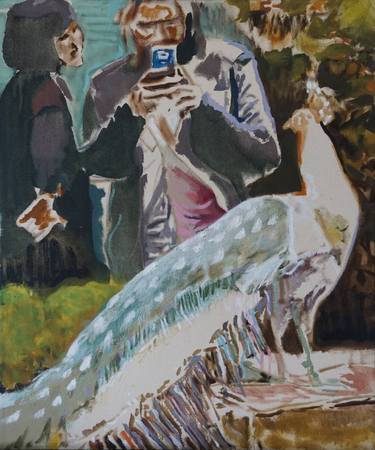Grasping Composition and Color in Figurative Oil Painting
Grasping Composition and Color in Figurative Oil Painting
Blog Article
The Role of Feeling and Expression in Metaphorical Oil Paint: A Comprehensive Analysis of Topic Matter and Make-up
The interaction of emotion and expression in metaphorical oil paint offers as a critical lens with which one can analyze the detailed relationship in between subject issue and composition. Artists harness different methods, from color option to brushstroke dynamics, to cultivate psychological vibration within their works.
Recognizing Feeling in Art
Emotion in art acts as an effective conduit for expression, enabling musicians to convey intricate feelings with their job. In figurative oil painting, this emotional deepness is usually represented via the representation of the human figure, catching the subtleties of human experience. The option of subject matter, color combination, and brushwork all add to the emotional vibration of a piece.
Artists often bring into play individual experiences, social concerns, or global motifs to stimulate feelings in the viewer. For circumstances, a picture may mirror susceptability, while a dynamic figure in movement can signify liberty or turmoil. These emotional threads link the customer to the art work, fostering a discussion that transcends the aesthetic tool.
Furthermore, the interaction between light and darkness can enhance psychological strength, directing the visitor's stare and accentuating particular aspects within the structure. Using texture in oil paint further includes layers of intricacy, inviting a tactile feedback that enhances the emotional experience. Overall, comprehending feeling in art is vital for appreciating the subtleties that characterize metaphorical oil painting, as it changes plain representation into a profound exploration of the human problem.
Crucial Element of Composition
In the realm of figurative oil paint, the composition offers as the underlying structure that arranges visual components and improves the psychological story. Necessary parts of composition include equilibrium, comparison, prime focus, and rhythm, each adding to the general effect of the art work.
Balance describes the circulation of visual weight within the painting, which can be attained through balanced or asymmetrical plans. A well-balanced composition offers security, enabling the customer to engage with the item sympathetically - figurative oil painting. Comparison, on the other hand, includes juxtaposing various elements, such as dark and light or warm and awesome shades, to lead the visitor's eye and stimulate psychological responses
The prime focus is vital, as it routes attention to the most significant component of the painting, frequently highlighting the emotional core of the narrative. Through methods like color saturation or positioning, artists can emphasize this location successfully. Rhythm pertains to the repeating of components, developing a feeling of motion and circulation throughout the make-up. By skillfully incorporating these key elements, musicians can craft compelling and emotionally powerful figurative oil paints that captivate and involve their audience.
Topic Issue and Its Influence
Topic plays an essential role in metaphorical oil paint, as it not only works as the structure for the narrative yet also forms the viewer's interpretation and psychological interaction with the artwork. The choice of subject-- be it a solitary number, a team dynamic, or a thematic depiction-- straight influences the psychological ambience shared to the target market.

For example, pictures typically stimulate individual links, revealing the ins and outs of human expression and personality, while scenes illustrating public activities can produce a sense of belonging or fond memories. The cultural and historical context of the subject matter improves the viewer's understanding, motivating much deeper representations on societal standards, worths, and the human problem.
Various subjects likewise produce differing levels of interaction; a remarkable conflict depicted through numbers in tension might generate sensations of anxiety or compassion, while tranquil landscapes can invoke serenity and reflection. Inevitably, the effect of subject in metaphorical oil paint is extensive, as it works as an avenue for psychological vibration, assisting the audience's feedback and interpretation, and promoting a connection between the artwork and the observer. This interplay is important for the successful interaction of the musician's intent.
Strategies for Evoking Feelings
The performance of metaphorical oil paint in sharing feelings is dramatically affected by the techniques utilized by the musician. One of one of the most vital techniques is using color concept, where the calculated option of hues can evoke specific psychological reactions. Warm colors, such as oranges and reds, commonly evoke sensations of interest or aggression, while cooler tones like blues and greens have a tendency you can try this out to stimulate peace or despair.
Another important method is the adjustment of light and darkness, called chiaroscuro. This approach improves the three-dimensionality of numbers, developing remarkable contrasts that can magnify psychological deepness. The positioning of light can lead viewers' emotions, highlighting details components of the make-up.
Brushwork likewise plays an essential role; loose, expressive strokes can convey power and spontaneity, whereas smoother strategies might suggest tranquility or accuracy. Additionally, the plan of subjects within the structure can influence psychological influence. Close closeness can suggest intimacy, while distance may show isolation.
Ultimately, the mix of these strategies enables musicians to craft narratives that reverberate with the visitor, transforming a simple aesthetic experience right into an expressive psychological trip. - figurative oil painting

Situation Researches of Noteworthy Functions
Analyzing notable works of figurative oil painting exposes how numerous methods are utilized to stimulate powerful emotions. One excellent situation is Edvard Munch's "The Scream," where the altered number and swirling background convey existential fear. Munch's use of color-- deep blues and vibrant oranges-- intensifies the psychological effect, showcasing just how palette selections can form visitor experience.
Another substantial work is Pablo Picasso's "Les Demoiselles d'Avignon." Here, strong brushstrokes and fragmented types mirror a tumultuous psychological landscape, challenging standard depictions of the female number. Picasso's cutting-edge make-up not only captures the visitor's focus yet likewise invites contemplation on themes of identification and sexuality.
In Addition, Frida Kahlo's "The 2 Fridas" offers a touching exploration of duality and self-identity. The different figures, connected by a shared heart, exhibit Kahlo's psychological depth and individual story. figurative oil painting. Her meticulous attention to information and symbolic elements offer to involve visitors on a visceral level
These case researches emphasize the extensive connection in between feeling and make-up in figurative oil painting, revealing exactly how artists harness strategy to connect intricate sensations and narratives that resonate across time and society.

Verdict
In conclusion, the interplay of emotion and expression in metaphorical oil paint considerably boosts the viewer's experience and analysis of the artwork. With a read here careful choice of subject and compositional strategies, artists share extensive narratives that reverberate on both personal and universal degrees. The application of color brushwork, chiaroscuro, have a peek at this site and theory further intensifies psychological depth, changing each canvas right into a powerful reflection of the intricacies of the human experience.
In metaphorical oil painting, this psychological deepness is commonly portrayed through the depiction of the human figure, recording the subtleties of human experience.Furthermore, the interplay between light and darkness can magnify emotional strength, leading the viewer's stare and attracting attention to particular components within the make-up. The use of appearance in oil painting further adds layers of complexity, welcoming a tactile feedback that boosts the psychological experience.The focal factor is essential, as it routes focus to the most considerable part of the paint, often highlighting the psychological core of the narrative. Inevitably, the influence of subject issue in metaphorical oil painting is profound, as it offers as a conduit for emotional vibration, leading the visitor's feedback and interpretation, and promoting a link in between the onlooker and the art work.
Report this page